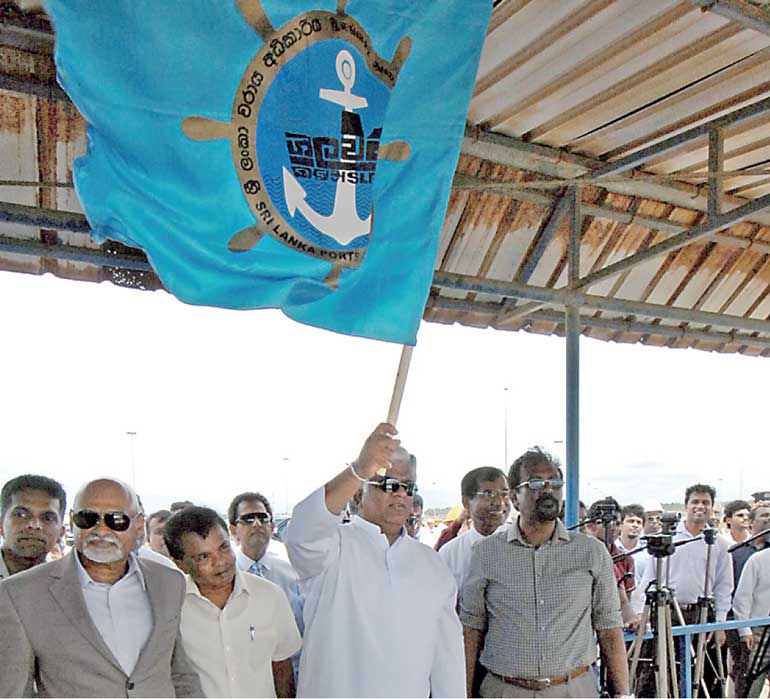Thursday Jan 15, 2026
Thursday Jan 15, 2026
Monday, 13 July 2015 00:00 - - {{hitsCtrl.values.hits}}
 The basin of the port being filled with seawater
The basin of the port being filled with seawater
A ceremony where the basin of the Hambantota Port was filled with sea water, as part of the port’s second phase of development, was held on 11 July in the presence of Ports and Shipping Minister Arjuna Ranatunga.
Along with the minister, Sri Lanka Ports Authority (SLPA) Acting Chairman Capt. Asitha Wijesekara, Board Director Saliya Senanayake, Director S.P.D. Ajil Hewageegana and a number of senior officials also attended the vent.
Presently, the basin has been fully excavated and was filled with sea water on Saturday. The total size of the water basin is 84 hectares. It holds 14 million cm of seawater. After it is filled with water, the 110-metre-long Coffer Dam, which was constructed under the first and second phases of development work, will be removed.
The first phase of work on the Hambantota Port commenced in 2007. Its complete cost exceeded $ 500 million and 90% of this was funded by a loan granted by the EX-IM Bank of China. This was done even though proper feasibility studies were not carried out regarding the viability of repayment. This meant that over Rs. 7 billion per year would be paid. This was a burden to the port and was not profitable when compared with the investment.
The fuel storage complex commenced its activities in 2009. Fourteen oil tanks with a capacity of 80,000 cubic metres were constructed under this project.
 Minister of Port and Shipping Arjuna Ranatunga signalling the commencement of the process of filling the port’s basin with seawater. Secretary to the Ministry of Port and Shipping L.P.Jayampathi, Act. Chairman of Sri Lanka Ports Authority (SLPA) Capt. Asitha Wijesekara, Director to the BOD SLPA Saliya Senanayake, Director S.P.D. Ajil Hewageegana and several top officials are also present
Minister of Port and Shipping Arjuna Ranatunga signalling the commencement of the process of filling the port’s basin with seawater. Secretary to the Ministry of Port and Shipping L.P.Jayampathi, Act. Chairman of Sri Lanka Ports Authority (SLPA) Capt. Asitha Wijesekara, Director to the BOD SLPA Saliya Senanayake, Director S.P.D. Ajil Hewageegana and several top officials are also present
Among these tanks, there are eight tanks of fuel for ships, three tanks of fuel for aeroplanes and three tanks for liquidised petroleum. However, it could not generate a significant level of income as the operations were not carried out in a proper manner or according to appropriate standards. New operational activities of the fuel complex constructed under the first phase of development work on the Hambantota Port will be initiated by the present Government within the next few months. The assistance of bunker brokers is expected be obtained for this purpose. The aim is to make the Port of Hambantota the best bunker hub in Asia.
The transhipment of vehicles commenced at the Port of Hambantota in 2012. The main aim of the present Government is to expand the transhipment of vehicles through the Port of Hambantota by increasing productivity by coordinating with vehicle manufacturing companies and specific shipping lines transporting vehicles in mega vessels through shipping routes. The Port of Hambantota will be able to tranship vehicles manufactured in Japan and India to East Africa, the Gulf region and Europe, through the Hambantota Port.
Work on the second phase of the Hambantota Port commenced in 2012. The Government expects to successfully complete the second phase of development without overburdening the national economy.
It also plans to bring in various businesses with a new force to the second phase of work on the port.
Accordingly, action is being taken to invite international investors to harness potential opportunities for a third time.
Actions are also being taken to construct a main ship repairing centre at the Port of Hambantota. The ship repairing centre will consist of drydocks and floating docks. The whole of the loan taken under the second phase will be paid off from the revenue derived from the port without adversely affecting the economy. The Port of Hambantota is expected to carry out multiparty businesses by mobilising reputed excellence in the global marine field.
Completion of berth and possession of related equipment, including operational equipment, the development of roads and construction, water and electricity works, other constructions and an efficient fire extinguishing unit will be established under the future development activities of the Hambantota Port. All these activities will be completed before the end of this year.
The Government seeks to transform the port into an organ which acts as a catalyst for significant socioeconomic development, delivering valuable economic benefits through several value-added products and services.